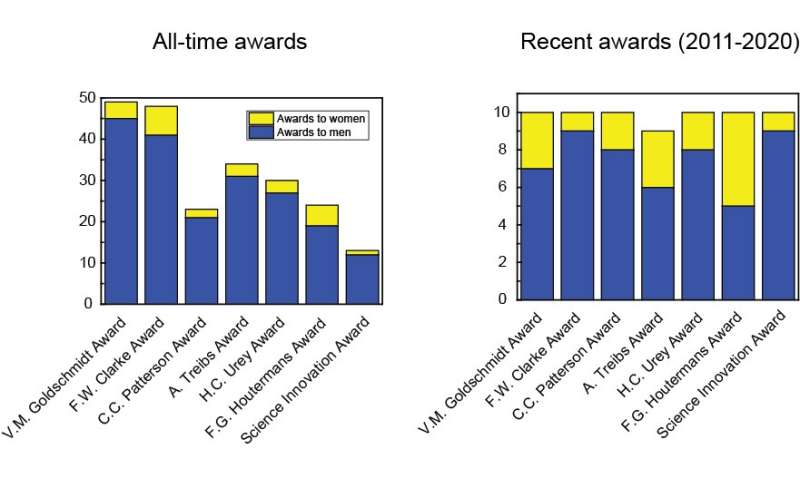Disparity in awards for geochemistry

Diversity drives innovative research at every step along the scientific path. Scientific societies, like the Geochemical Society (GS) and the European Association of Geochemistry (EAG), have a significant influence over which discoveries and innovators are celebrated. Such choices impact the future of research, and therefore influence the evolution of our discipline and its relationship to the global community.
Our professional societies are well positioned to define and promote the success of all scientists, including those from under-represented groups, through proactive advocacy, inclusive mentorship, awards, and leadership. At present, only binary gender data are available to examine the distribution of under-represented groups among memberships, awardees, and leadership positions.
In our review paper, we probed the nature of the awards bestowed by the EAG and the GS. Our work critically evaluates inequities and suggests a number of reforms to improve inclusion and accessibility for all geochemists. Related presentations on this topic, and community demographics, along with opportunities for questions & answers and exchange of ideas in chat forums shall take place at the Goldschmidt conference early July 2021.
Awards have in the past been disproportionately given to white men, though this is changing (see Figure). Of 221 awards in the above categories, 196 (89 percent) were bestowed upon men and 25 (11 percent) were awarded to women. It is the same for fellowships (316 awardees, with 274 men and 42 women; 87/13 ratio). Gender ratios of awards in the last decade (2011-2020) have improved slightly. Of 69 awards and 132 fellowships, 52 (75 percent) awards went to men and 17 (25 percent) went to women whereas 104 (79 percent) fellows were men and 28 (21 percent) were women. Two-thirds of all awards to women were bestowed in the last ten years (68 percent).
The GS and EAG have taken positive steps to increase both diversity of awardees (e.g., broadened definition of Fellows criteria) and inclusion (e.g., mentoring efforts aimed at early career and underrepresented minority scientists).
Our work identifies strategies to continue to improve professional societies' recognition of excellent science resulting in a more diverse representation of awardees.
The strategies (e.g., revisions to award criteria and procedures to enlarge and diversify nomination pools) will require ongoing analysis and modifications.
Future work is needed to address historically under-represented groups. We must work together to create a legacy of inclusion.
This story is part of Science X Dialog, where researchers can report findings from their published research articles. Visit this page for information about ScienceX Dialog and how to participate.
More information:
Olivier Pourret et al, Diversity, Equity, and Inclusion: tackling under-representation and recognition of talents in Geochemistry and Cosmochemistry, Geochimica et Cosmochimica Acta (2021). DOI: 10.1016/j.gca.2021.05.054
Associate Professor of Geochemistry, Head Scientific Integrity and Open Science, UniLaSalle, Beauvais, France - Member of DEI committees from EAG and GS.
My research interests include trace metal fractionation and particularly Rare Earth Elements and cobalt in low-temperature aqueous systems, from rock to water, soil and vegetation.
I advocate for Open Science, just Science done right, and get involved in various DEI initiatives, especially fighting against disability's discrimination since one of my son have a rare genetic disease.